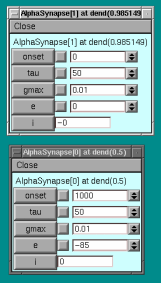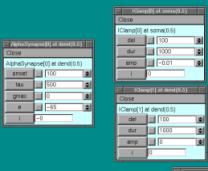
Synaptic excitation and inhibition
This series of simulations will demonstrate excitation and both conventional and “silent” inhibition. The model cell is composed of a soma (25u.x25u.) Attached to an equivalent cylinder (1000 u. = 0.5 lambda long.) An excitatory synapse is put at the end and an inhibitory synapse in the middle of the cylinder.
Bring up the simulation by typing spike eandi.hoc -
Close the “NEURON Main Panel” and retrieve the session file ‘eandi.ses’

Excitatory synapse at end of “dendrite”
Inhibitory synapse in the middle of “dendrite”
Press “Init and Run”; observe that the excitatory event begins at 0 ms. And the inhibitory at 1000 ms.
Now change the equilibrium potential of the inhibitory synapse from -85mV. to the resting potential of -65mv. Observe what happens.
Now try both of these conditions with excitation and inhibition occurring simultaneously by changing the “onset” time of the inhibitory synapse from 1000 to 0 ms. Observe.
Measuring Input Resistance during synaptic inhibition
The input resistance of a cell is determined by injecting a known current and measuring the resulting voltage potential change. Then input resistance is calculated using Ohm’s law:
Input Resistance = Voltage / Current
Start the simulation again ( spike eandi.hoc - ) and retrieve the session file ‘eandi2.ses’ The session comes up with an alpha-synapse in the middle of the “dendrite”
and 2 current injection sites, one in the soma and another at the point of the alpha-synapse.

With the default settings on these controls
the input resistance without inhibition can be
determined.
Turn on inhibition by setting the alpha-
synapse gmax = -.01 mohs.
How does inhibition change the input resistance of the cell?
Try this with the clamp at the site of inhibition and compare with the soma clamp.